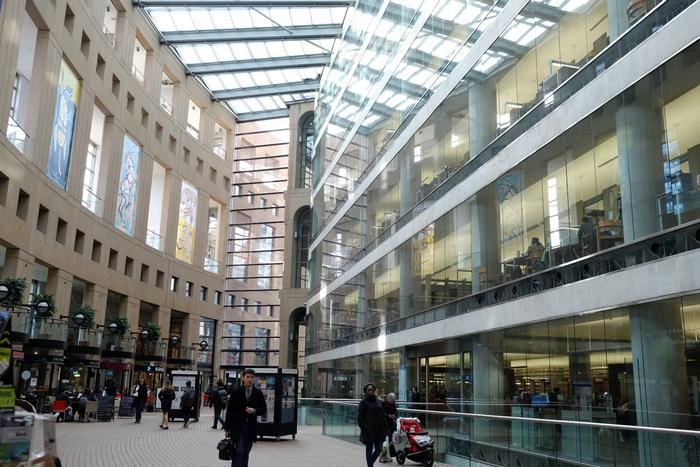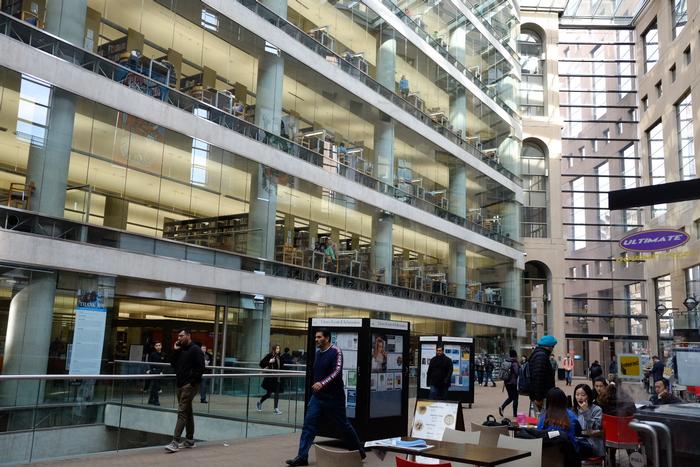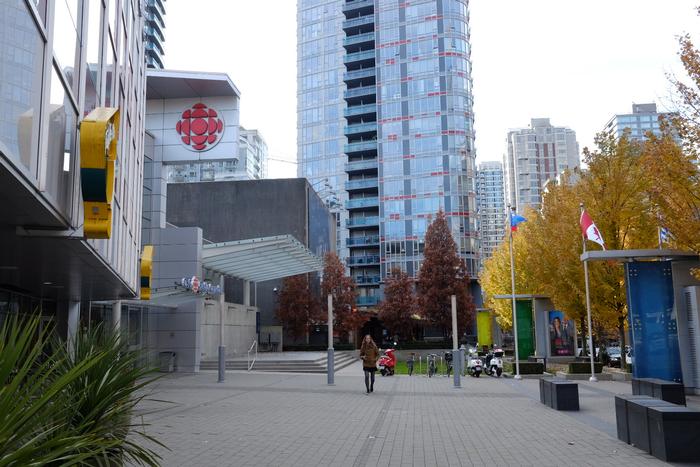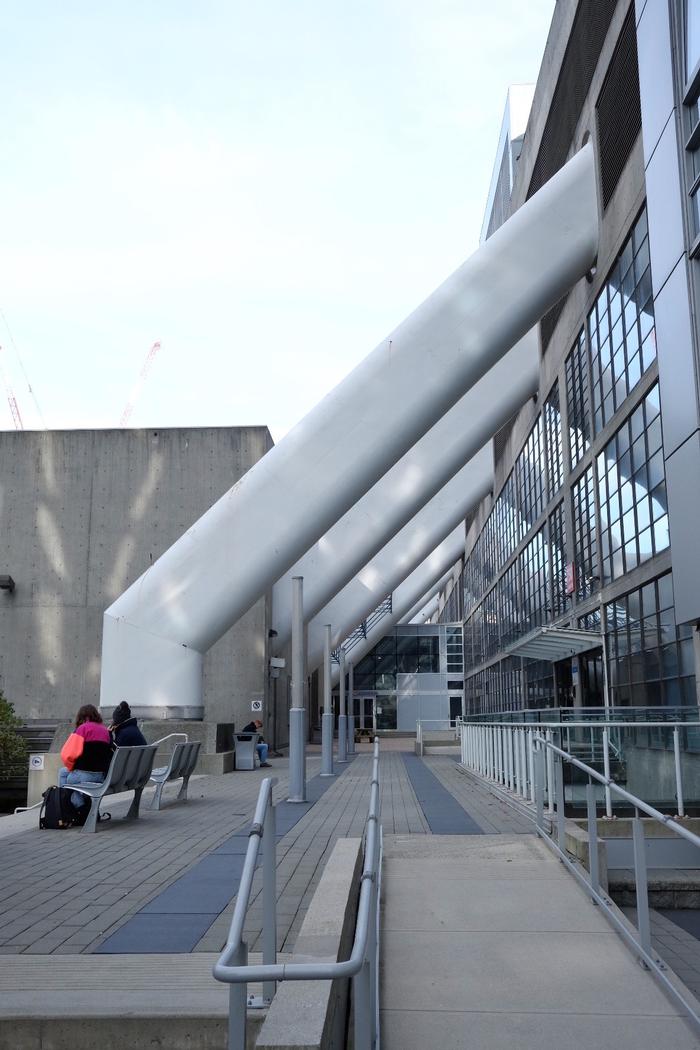Claudio Cabana and Henrike Scholz - EssayThe Learned City: Civic Buildings, Information Inequality, and the Digital DivideThis co-authorship was inspired by our intersecting backgrounds: one in architecture, the other in international relations with a focus on gender, race and social justice. Civic spaces serve an increasingly complex and diverse public, and must account for the multi-faceted relationships between individuals, their rights, and their social needs. If knowledge is indeed power, universal access to the Internet at the touch of a finger should entail the end of ignorance, apathy, and inequality among liberal-democratic societies. However, far from the free-information utopia once heralded, easy and universal access to information has made our societies more unequal, eroded public trust in media and news, and collectively altered the way in which we learn and grow - often in negative ways. Two civic buildings in our city, the Vancouver Central Library and the Canadian Broadcasting Corporation's (CBC) regional centre, serve as critical resources in harnessing the age of information and providing spaces, activities, interactions, and amenities to keep the diverse public learning, growing, and becoming better informed. The pairing of these two buildings is rooted in our desire to contribute to a current conversation about the future of the publicly-funded CBC, whose funding structure is currently under review by the federal Broadcasting and Legislative Review Panel. Many are advocating for an overhaul of the public broadcaster's role and mandate in the context of ever-greater broadband penetration, the diffusion of new medias and competition from private entertainment companies. This essay will draw from the long-standing impact of public libraries, and the VPL specifically, to make recommendations that should guide the CBC's transformation for a new century. We argue that both institutions not only share similar responsibilities to the public, but that they can be powerful complements as they prepare for the considerable social change that is sure to define upcoming decades. The public library is a remarkably modern concept. Historically, the library was a domain of social exclusion: private repositories to which few people had the privilege of access, education and literacy notwithstanding. The libraries of monasteries, cathedrals, palaces, and universities were integral to their social, cultural, and political influence. Religious texts were among the only collections of knowledge that were dispersed en masse, often requiring the translation or interpretation of literate priests or leaders. News, or daily events, were published locally or spread by word of mouth, but rarely did they serve the purpose of intellectual development beyond local happenings. The emergence of the free public library in the nineteenth century catalyzed a new era of democratized learning. The modern institution of the public library began to gain traction in England after the Public Libraries Act of 1850. The paternalistic Victorian middle class felt that spending free time on morally uplifting activities, such as reading, would promote greater social good, and that the provision of public libraries would “steer people towards temperate and moderate habits,” as well as lower crime rates. The construction of free public libraries began throughout the English-speaking world, with Vancouver opening its first central branch in 1903 and upgrading to a bigger building in 1957. By the 1970s, the vitality and variety of downtown Vancouver had been reduced through the introduction of large single-program buildings spanning entire blocks, supported by vehicular use and parking lots. This had diminished pedestrian movement and civic life on the streets. The CBC building is emblematic of this time, in the ignorance of its design towards street life. The tower is part of the brutalist tradition— coined from the French béton brut, referring to concrete left raw, as poured— and is nicknamed “the bunker” by the CBC staff who despised that the studios had been designed underground, for acoustic reasons. It is crowned with space-age looking satellites and broadcasting equipment on the roof. The mechanical systems are on the top floors from where six giant ventilation ducts— set outside to prevent transmission of vibrations to the studios— plunge to a plaza, creating an effect that, while invigorating, is more industrial than cultural. The demise of the office market in the 1990’s forced the city to rethink its urban future, and an idea emerged to relocate the city’s public library to a city-owned block between Georgia and Robson to act as a major people attractor. The planners’ intentions were to use the library to create a mixed-use civic nucleus with a variety of public spaces and facilities. The holding of an architectural competition for the library design was a first for the city in modern times and it proved a fascinating experience for the design professions and the public. The participatory nature of this competition created a conversation between these stakeholders that lead to a democratic and inclusive design being built. The jury was chaired by Mayor Gordon Campbell, who gave the project a thumbs up after 70% of the public vote— based on the three finalists’ models, exhibited anonymously— favoured the concept. Designed by Moshe Safdie partnered with Downs/Archambault, its form and imposing proportion employs a postmodern reference to the classical Roman colosseum. The oval form is disrupted when the entire south-eastern portion of the facade is split open and peeled back to allow a conch-like entrance to the complex. Within the space created by this move, the visitor first enters a six-storey high atrium. On one side the repeating openings perforate the brick wall curving around the space, lined with cafes and souvenir shops at ground level. Opposite, a modernist glass cube reveals each floor slab of the library, visitors bent over desks or browsing bookshelves. The structure refracts light back into the atrium, which is perpetually full of bustle and movement, a safe public space that is sheltered from rain and wind. When the weather is fair, the curved steps of the southern plaza provide great sitting spaces for reading, sunning, and people watching, while a vegetated rooftop plaza designed by renowned local landscape architect Cornelia Oberlander acts as a more peaceful refuge that feels further from the busyness of the street. The result is an iconic postmodern building very much at odds with Vancouver traditions. Many critics of the design, mostly from the profession, claimed that a more regional style, namely West Coast Modernism, should have been selected, perhaps unconscious of the elitist connotations involved. But the public vote showed that Safdie’s scheme was publicly liked as “unique, imaginative, exciting, interesting building”. The building has since withstood architectural criticism to enjoy great public acclaim. Library visitors increased by 800,000 in the year following its opening, and it continues to accommodate over two million visitors annually, equivalent to the annual attendance at all professional sport events in the city in the mid-1990s. This success spilled-over to surrounding blocks, prompting a new character area description that sought to increase pedestrian amenities and complementary spaces with special tree planting, paving treatments, furniture, and lighting. Due to the VPL’s proximity to the Downtown Eastside, metro Vancouver’s poorest neighbourhood, the sociodemographic it serves is large and diverse. The library is one of the only public places in the downtown area where homeless people can legitimately be indoors. The design is evidence that this building acts as a vital resource to the city, and the community it created. In the early 2000’s, the growth of the Internet and connectivity gave rise to the concept of the ‘digital divide’ – the gulf between those who have ready access to information technologies - and the literacy to make quality use of them - and those who do not. As the diffusion of communication technologies has grown, especially in wealthier countries like Canada, information inequality has only deepened. The VPL recognized that these issues and changes were intimately tied with their mandate and responsibility to the wider public. The changing role of the VPL central branch to the community is made evident in trends of library use. A 2011 study by Kay Cahill found that informational reference questions at the library are steadily falling, while visits to the VPL web site are increasing. These trends combined with the fact that in-person visits to the library have remained constant in recent years suggest that the nature of library usage has fundamentally shifted to be more virtual and technological, while the VPL remains a vital information access point for the Vancouver public. The VPL has been successful in catering its services to the needs of the community, for example by coordinating program times with local shelter intakes and soup kitchen meals to reduce exclusion of the homeless. As services ranging from job search to healthcare become increasingly reliant on information and communication technologies, there is a growing need to provide digital access and literacy to groups that fall on the wrong side of the digital divide, who are already affected by inequalities when it comes to health, and employment. (sexual and racial/ethnic minorities, immigrants, people with disabilities). Gladiator-like, thousands of daily visitors cross over the suspended bridge of the atrium into the public library in need of these services. The nine available levels of rich library resources and diverse spaces are interspersed with rows of computers, desks, study rooms, projectors, scanners, printers, and TVs, not to mention the endless bookshelves. Each space employs strategies to encourage concentration, interaction, contemplation, or simply provides a safe space for spending time. Never far away, a welcoming librarian is always ready to direct one to the desired topic or resource, while curated selections of books are on display in every floor. Varying workshops provided by the library, which range across topics like computer essentials, job searching, podcasting, coding, WeChat, Indigenous ancestry searching, and money budgeting are lead by animated librarians, professionals, and community members. These services not only provide access to information, but guide the public in how to access and understand information wisely and effectively. From the topics, one can tell that many of these are tailored to elderly, teen, immigrant, and marginalized populations, all of them free of cost. And they take place in the labs, classrooms, lounges, recording studios, and safe spaces within the Central Library building. The diverse and dynamic programming of the VPL is starkly contrasted by the still multi-functional space occupied across the street at the CBC centre. It no longer occupies the entire block, having sold its parking lot to Concord Pacific Developments, a large corporate developer, in 2009. Concord built two 26-storey luxury residential towers which are a manifestation of the privatization, gentrification, and unaffordability that plague the city today. The funds from this sale were used to construct a new addition to the CBC studios, bringing them out of the underground and onto the plaza beneath the giant ducts. The sleek, ‘transparent’ (archi-babble for using a glass facade), new addition designed by popular regional firm Dialog, allows the public a mere glimpse of news broadcasts from the street level below. Not even the lobby, which has windows that do overlook the studios, is accessible to the public. The plaza which is now a sixth of the size, is designed by PWL Landscape Architects, and includes ‘The Wall’ a public art initiative that periodically displays something on, yes, a wall. A JJ Bean coffee stall with patio tables does attract pedestrians into the space, and a stage for summer concerts are a popular lunch break attraction. However, these developments on the CBC site bear a lot of resemblance with the criticisms that the CBC as an institution is receiving. The CBC should inhabit an important role of public sphere pedagogy for Canadian society, whose mandate according to the Broadcasting Act is to “inform, enlighten and entertain”. And yet the Corporation has come under criticism for diluting its mandate in the process of adapting to new technologies and competing with increasingly popular private entertainment companies. Some argue that the CBC's pursuits in audience maximization to secure greater advertising revenue in recent years has undermined the informative nature of programming in favour of entertaining content with a greater reach. As the world of information moves away from television and radio, the CBC must look to adapt its role to optimize its benefit to the public. A report issued by the CBC in January 2019 titled ‘Canada in the Digital World’ shows that the Corporation is reorienting its strategy to cater to newer medias, but also that digital inequality is not on its agenda and that efforts to reach a wider audience are not injected with an adequate understanding of the communities that are underserved by the spread of information and communication technologies. The regional broadcasting centre in Vancouver, acting as a physical embodiment of the Corporation's mandate, has the unique opportunity to tap into the city's diverse community in a way that complements its digital broadcasts. We argue that the CBC must reorient its approach to technological change, learning from the VPL’s commitment, readiness and devotion to keeping the public well-informed. A possible direction we see the CBC taking is an increased physical presence through its downtown location. Providing not just news, but in-person workshops to understand the news and its production - perhaps even by directly collaborating with the VPL’s human resources - could provide great public benefit. The lobby of the CBC building represents untapped potential for this, as well as the ground floor of the studios which is currently leased to a fast-food burger chain, and seems extremely under-utilized. Online courses for these topics could also be a way to broadcast understanding, as opposed to broadcasting more content to a digital space already saturated with news and entertainment content. In a world where information and technology are inextricably linked, public institutions function as vital access points from which community members can access online services and develop their digital literacy. Schools, libraries and community centres are vital portals of digital inclusion for disadvantaged groups who lack consistent access to hardware, software, the internet, and cellular data due to socioeconomic status and related factors like housing stability. Public institutions can reduce information inequalities and allow minorities (in a digital context) to grow their communities in ways that translate into real changes in economic and social capital. They also play an increasingly important role in fostering democracy as the Internet and social media have become the public's primary source of information. Promoting digital access and literacy can facilitate inclusion and productive participation in politics for underrepresented groups, for example the homeless or recent immigrants. As we have shown, the Vancouver Central Public Library is successfully catering to Vancouver's diverse communities, and strives to harness the potential that technology plays in informing the public while the Canadian Broadcasting Corporation is turning to new medias but without an adequate understanding of how some groups are underserved by information & communication technologies, and how they could better serve a well-informed citizenry. Additional Help and InformationAre you in need of assistance? Please email info@berkeleyprize.org. |
|




